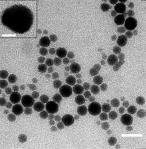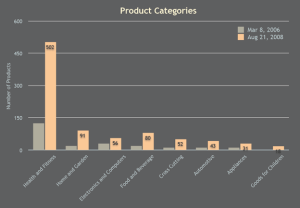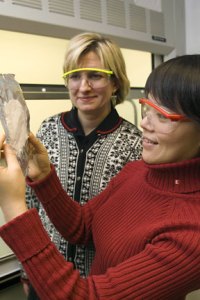Silver nanoparticles, untested for safety, are being used in a growing number of children’s toys, babies’ bottles, cosmetics, dishwashers, underwear and hundreds of other items.
A report issued today says that consumers and workers who make the products may be at risk.

Silver nano particles Photo ACA
The report, authored by Friends of the Earth and Health Care Without Harm Europe, details what they call “the growing public health threat posed by nano-silver particles in consumer products.”
“What we’ve learned is alarming,” said Ian Illuminato, one of the report’s authors.
“Major corporations are putting nano-silver into a wide variety of consumer products with virtually no oversight, and there are potentially serious health consequences as a result. The workers who manufacture these products, the families that use them, and the environment are all at risk.”
Human consumption of silver is not new and medical historians have traced its health benefits back

Ian Illuminato, Friends of the Earth
more than a century. At that time, the literature reports, people had ready access to beneficial silver in their diet because it was plentiful in surface and ground waters.
“What we’re concerned about is when the silver is scaled to nano size because evidence shows that it is far more potent. That potency – the impact on human health – is what is we don’t yet know,” Illuminato told me.
His concern is shared by other scientists who also worry that nanosilver doesn’t distinguish between good and bad bacteria. It kills all bacteria, even the good bacteria that humans and animals need to survive.
“We are playing with fire, especially at a time when anti-bacterial resistance is an ever increasing medical problem globally,” said report co-author Dr. Rye Senjen, of Australia.
“Do we really need to coat cups, bowls and cutting boards, personal care products, children’s toys and infant products in nano-silver for ‘hygienic’ reasons?” he asked.
The Korean manufacturer Samsung made the first clothes washer with a nanosilver-coated drum and said it would kill over 600 different bacteria.
Nanoparticles are one billionth of a meter in size or, as one scientist told me at a nano-in-food conference this week in California, “Slice a human hair lengthwise into a 100 slivers and a single one of those is what we’re dealing with. We are manipulating single molecules and atoms.”

Andrew Maynard
The Project on Emerging Nanotechnologies, one of the best known centers for nanotech policy research, presented testimony before Congress last year and cautioned that hundreds of products with nano particles are on the market, with three to five new ones added every week.
Andrew Maynard, the lead scientist for the Project, told me in an telephone interview from the Regulating Nanotechnology in Food and Consumer Products conference in Brussels yesterday, that the report raises some uncertainties that must be addressed.
“There is no indication that silver at the nano scale goes wild in the body. However, it is known that silver becomes more toxic at the nano level,” Maynard explained, adding, “That does not mean it always does more damage.
“More research must be done.”
A coalition of consumer protection, public health and environmental groups filed a petition with the Environmental Protection Agency demanding the agency halt the sale of consumer products containing silver nanoparticles
The petition called for the EPA to:
* Determine the potential human health and environmental hazards from nanosilver with nano-specific toxicity data requirements, testing and risk assessments.
* Clarify that nano-silver is a pesticide and thus must undergo the rigorous and extensive testing process involved in registering a pesticide. Moreover, products with nano-silver must carry a pesticide label.
* Take immediate action to prohibit the sale of nano-silver products as illegal pesticide products with unapproved health benefit claims.
The authors of the report say that EPA is not “doing near enough” to address the hazard.
“This report should be a kick in the pants to EPA to start fining companies that use nanosilver without going through the registration process,” Dr. Jennifer Sass, senior scientist and nano specialist for the Natural Resources Defense Council, who is also speaking at the Brussel’s meeting told me in an email.
EPA says it is ready to take action if asked.
“The EPA is prepared to address the nanosilver issue but nobody has applied to the EPA with a product. It hasn’t happened,” said Dale Kemery, an agency spokesman.
Nanoized silver is not the only metal that worries regulators and the public health community. Carbon nanotubes, nano zerovalent iron, cerium oxide and others are on some government hot lists.
The California Department of Toxic Substances Control has ordered all manufacturers who manufacture, import, sell or use nano material with those metals to supply the department with extensive information on their source, use, transport, and disposal.
According to the EPA and FDA, they have no plans to collect similar information.
The debate, to some extent, centers on semantics. Pesticides kill bugs and other things and their use is controlled by the government.
The Nanotechnology Industries Association and other trade groups insist that nanosilver is antimicrobial – it goes after germs – and is not a pesticide.



